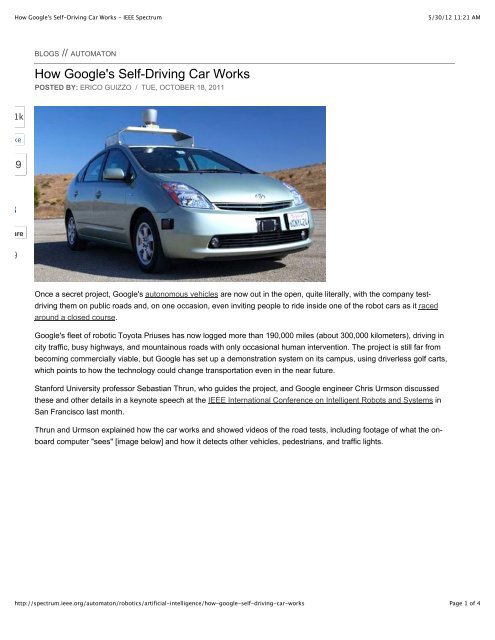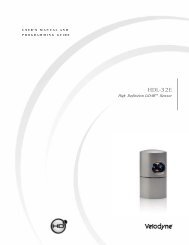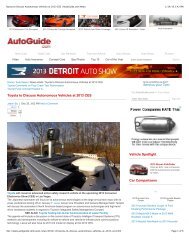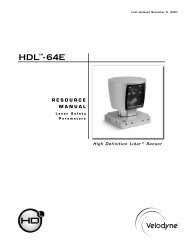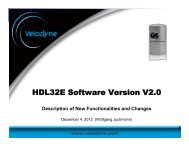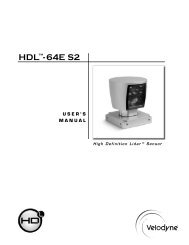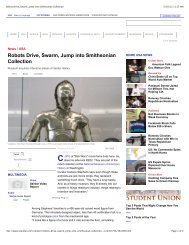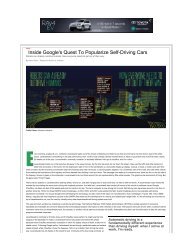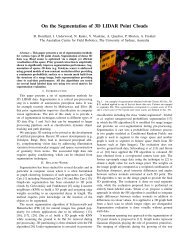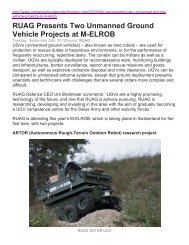How Google's Self-Driving Car Works - IEEE ... - Velodyne Lidar
How Google's Self-Driving Car Works - IEEE ... - Velodyne Lidar
How Google's Self-Driving Car Works - IEEE ... - Velodyne Lidar
- No tags were found...
Create successful ePaper yourself
Turn your PDF publications into a flip-book with our unique Google optimized e-Paper software.
<strong>How</strong> <strong>Google's</strong> <strong>Self</strong>-<strong>Driving</strong> <strong>Car</strong> <strong>Works</strong> - <strong>IEEE</strong> Spectrum<br />
5/30/12 11:21 AM<br />
BLOGS // AUTOMATON<br />
<strong>How</strong> <strong>Google's</strong> <strong>Self</strong>-<strong>Driving</strong> <strong>Car</strong> <strong>Works</strong><br />
POSTED BY: ERICO GUIZZO / TUE, OCTOBER 18, 2011<br />
2.1k<br />
Like<br />
,259<br />
18<br />
Share<br />
449<br />
Once a secret project, <strong>Google's</strong> autonomous vehicles are now out in the open, quite literally, with the company testdriving<br />
them on public roads and, on one occasion, even inviting people to ride inside one of the robot cars as it raced<br />
around a closed course.<br />
<strong>Google's</strong> fleet of robotic Toyota Priuses has now logged more than 190,000 miles (about 300,000 kilometers), driving in<br />
city traffic, busy highways, and mountainous roads with only occasional human intervention. The project is still far from<br />
becoming commercially viable, but Google has set up a demonstration system on its campus, using driverless golf carts,<br />
which points to how the technology could change transportation even in the near future.<br />
Stanford University professor Sebastian Thrun, who guides the project, and Google engineer Chris Urmson discussed<br />
these and other details in a keynote speech at the <strong>IEEE</strong> International Conference on Intelligent Robots and Systems in<br />
San Francisco last month.<br />
Thrun and Urmson explained how the car works and showed videos of the road tests, including footage of what the onboard<br />
computer "sees" [image below] and how it detects other vehicles, pedestrians, and traffic lights.<br />
http://spectrum.ieee.org/automaton/robotics/artificial-intelligence/how-google-self-driving-car-works<br />
Page 1 of 4
<strong>How</strong> <strong>Google's</strong> <strong>Self</strong>-<strong>Driving</strong> <strong>Car</strong> <strong>Works</strong> - <strong>IEEE</strong> Spectrum<br />
5/30/12 11:21 AM<br />
Google has released details and videos of the project before, but this is the first time I have seen some of this footage --<br />
and it's impressive. It actually changed my views of the whole project, which I used to consider a bit far-fetched. Now I<br />
think this technology could really help to achieve some of the goals Thrun has in sight: Reducing road accidents,<br />
congestion, and fuel consumption.<br />
Watch:<br />
Urmson, who is the tech lead for the project, said that the "heart of our system" is a laser range finder mounted on the<br />
roof of the car. The device, a <strong>Velodyne</strong> 64-beam laser, generates a detailed 3D map of the environment. The car then<br />
combines the laser measurements with high-resolution maps of the world, producing different types of data models that<br />
allow it to drive itself while avoiding obstacles and respecting traffic laws.<br />
The vehicle also carries other sensors, which include: four radars, mounted on the front and rear bumpers, that allow the<br />
car to "see" far enough to be able to deal with fast traffic on freeways; a camera, positioned near the rear-view mirror,<br />
that detects traffic lights; and a GPS, inertial measurement unit, and wheel encoder, that determine the vehicle's location<br />
and keep track of its movements.<br />
Here's a slide showing the different subsystems (the camera is not shown):<br />
http://spectrum.ieee.org/automaton/robotics/artificial-intelligence/how-google-self-driving-car-works<br />
Page 2 of 4
<strong>How</strong> <strong>Google's</strong> <strong>Self</strong>-<strong>Driving</strong> <strong>Car</strong> <strong>Works</strong> - <strong>IEEE</strong> Spectrum<br />
5/30/12 11:21 AM<br />
Two things seem particularly interesting about <strong>Google's</strong> approach. First, it relies on very detailed maps of the roads and<br />
terrain, something that Urmson said is essential to determine accurately where the car is. Using GPS-based techniques<br />
alone, he said, the location could be off by several meters.<br />
The second thing is that, before sending the self-driving car on a road test, Google engineers drive along the route one<br />
or more times to gather data about the environment. When it's the autonomous vehicle's turn to drive itself, it compares<br />
the data it is acquiring to the previously recorded data, an approach that is useful to differentiate pedestrians from<br />
stationary objects like poles and mailboxes.<br />
The video above shows the results. At one point you can see the car stopping at an intersection. After the light turns<br />
green, the car starts a left turn, but there are pedestrians crossing. No problem: It yields to the pedestrians, and even to<br />
a guy who decides to cross at the last minute.<br />
Sometimes, however, the car has to be more "aggressive." When going through a four-way intersection, for example, it<br />
yields to other vehicles based on road rules; but if other cars don't reciprocate, it advances a bit to show to the other<br />
drivers its intention. Without programming that kind of behavior, Urmson said, it would be impossible for the robot car to<br />
drive in the real world.<br />
Clearly, the Google engineers are having a lot of fun (fast forward to 13:00 to see Urmson smiling broadly as the car<br />
http://spectrum.ieee.org/automaton/robotics/artificial-intelligence/how-google-self-driving-car-works<br />
Page 3 of 4
<strong>How</strong> <strong>Google's</strong> <strong>Self</strong>-<strong>Driving</strong> <strong>Car</strong> <strong>Works</strong> - <strong>IEEE</strong> Spectrum<br />
5/30/12 11:21 AM<br />
speeds through <strong>Google's</strong> parking lot, the tires squealing at every turn).<br />
But the project has a serious side. Thrun and his Google colleagues, including co-founders Larry Page and Sergey Brin,<br />
are convinced that smarter vehicles could help make transportation safer and more efficient: <strong>Car</strong>s would drive closer to<br />
each other, making better use of the 80 percent to 90 percent of empty space on roads, and also form speedy convoys<br />
on freeways. They would react faster than humans to avoid accidents, potentially saving thousands of lives. Making<br />
vehicles smarter will require lots of computing power and data, and that's why it makes sense for Google to back the<br />
project, Thrun said in his keynote.<br />
Urmson described another scenario they envision: Vehicles would become a shared resource, a service that people<br />
would use when needed. You'd just tap on your smartphone, and an autonomous car would show up where you are,<br />
ready to drive you anywhere. You'd just sit and relax or do work.<br />
He said they put together a video showing a concept called Caddy Beta that demonstrates the idea of shared vehicles --<br />
in this case, a fleet of autonomous golf carts. He said the golf carts are much simpler than the Priuses in terms of onboard<br />
sensors and computers. In fact, the carts communicate with sensors in the environment to determined their<br />
location and "see" the incoming traffic.<br />
"This is one way we see in the future this technology can . . . actually make transportation better, make it more efficient,"<br />
Urmson said.<br />
Watch:<br />
Thrun and Urmson acknowledged that there are many challenges ahead, including improving the reliability of the cars<br />
and addressing daunting legal and liability issues. But they are optimistic (Nevada recently became the first U.S. state to<br />
make self-driving cars legal.) All the problems of transportation that people see as a huge waste, "we see that as an<br />
opportunity," Thrun said.<br />
PS: Don't miss the first part of the keynote, in which Thrun and Urmson describe their experiences at the DARPA<br />
autonomous vehicle challenges.<br />
Recommend<br />
2151 recommendations. Sign Up to see what your friends<br />
recommend.<br />
http://spectrum.ieee.org/automaton/robotics/artificial-intelligence/how-google-self-driving-car-works<br />
Page 4 of 4


